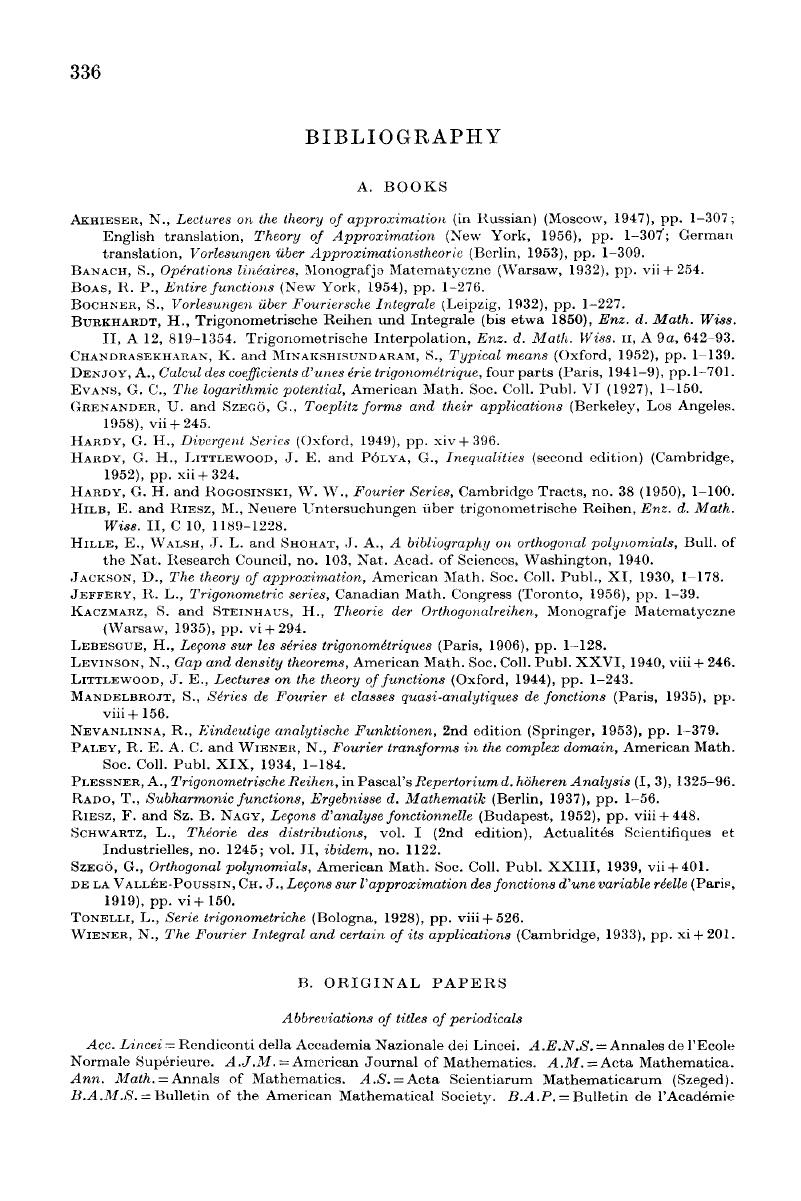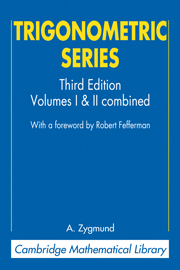Book contents
- Frontmatter
- Foreword
- TRIGONOMETRIC SERIES
- Contents
- Preface
- List of Symbols
- CHAPTER I TRIGONOMETRIC SERIES AND FOURIER SERIES. AUXILIARY RESULTS
- CHAPTER II FOURIER COEFFICIENTS. ELEMENTARY THEOREMS ON THE CONVERGENCE OF S[f] AND S[f]
- CHAPTER III SUMMABILITY OF FOURIER SERIES
- CHAPTER IV CLASSES OF FUNCTIONS AND FOURIER SERIES
- CHAPTER V SPECIAL TRIGONOMETRIC SERIES
- CHAPTER VI THE ABSOLUTE CONVERGENCE OF TRIGONOMETRIC SERIES
- CHAPTER VII COMPLEX METHODS IN FOURIER SERIES
- CHAPTER VIII DIVERGENCE OF FOURIER SERIES
- CHAPTER IX RIEMANN'S THEORY OF TRIGONOMETRIC SERIES
- Notes
- TRIGONOMETRIC SERIES
- CONTENTS
- CHAPTER X TRIGONOMETRIC INTERPOLATION
- CHAPTER XI DIFFERENTIATION OF SERIES. GENERALIZED DERIVATIVES
- CHAPTER XII INTERPOLATION OF LINEAR OPERATIONS. MORE ABOUT FOURIER COEFFICIENTS
- CHAPTER XIII CONVERGENCE AND SUMMABILITY ALMOST EVERYWHERE
- CHAPTER XIV MORE ABOUT COMPLEX METHODS
- CHAPTER XV APPLICATIONS OF THE LITTLE WOOD-PALEY FUNCTION TO FOURIER SERIES
- CHAPTER XVI FOURIER INTEGRALS
- CHAPTER XVII A TOPIC IN MULTIPLE FOURIER SERIES
- Notes
- References
- Index
- References
References
Published online by Cambridge University Press: 05 February 2015
- Frontmatter
- Foreword
- TRIGONOMETRIC SERIES
- Contents
- Preface
- List of Symbols
- CHAPTER I TRIGONOMETRIC SERIES AND FOURIER SERIES. AUXILIARY RESULTS
- CHAPTER II FOURIER COEFFICIENTS. ELEMENTARY THEOREMS ON THE CONVERGENCE OF S[f] AND S[f]
- CHAPTER III SUMMABILITY OF FOURIER SERIES
- CHAPTER IV CLASSES OF FUNCTIONS AND FOURIER SERIES
- CHAPTER V SPECIAL TRIGONOMETRIC SERIES
- CHAPTER VI THE ABSOLUTE CONVERGENCE OF TRIGONOMETRIC SERIES
- CHAPTER VII COMPLEX METHODS IN FOURIER SERIES
- CHAPTER VIII DIVERGENCE OF FOURIER SERIES
- CHAPTER IX RIEMANN'S THEORY OF TRIGONOMETRIC SERIES
- Notes
- TRIGONOMETRIC SERIES
- CONTENTS
- CHAPTER X TRIGONOMETRIC INTERPOLATION
- CHAPTER XI DIFFERENTIATION OF SERIES. GENERALIZED DERIVATIVES
- CHAPTER XII INTERPOLATION OF LINEAR OPERATIONS. MORE ABOUT FOURIER COEFFICIENTS
- CHAPTER XIII CONVERGENCE AND SUMMABILITY ALMOST EVERYWHERE
- CHAPTER XIV MORE ABOUT COMPLEX METHODS
- CHAPTER XV APPLICATIONS OF THE LITTLE WOOD-PALEY FUNCTION TO FOURIER SERIES
- CHAPTER XVI FOURIER INTEGRALS
- CHAPTER XVII A TOPIC IN MULTIPLE FOURIER SERIES
- Notes
- References
- Index
- References
Summary

- Type
- Chapter
- Information
- Trigonometric Series , pp. 728 - 744Publisher: Cambridge University PressPrint publication year: 2003



